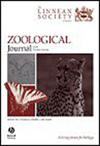Diversity in owls’ (Strigiformes) hindlimbs: evolutionary and ecological influences on hindlimb bone proportions and their relation to prey preferences
IF 2.8
2区 生物学
Q1 ZOOLOGY
引用次数: 0
Abstract
In Strigiformes, which comprise the Tytonidae and Strigidae families, hindlimbs play a crucial role in prey capture. Yet, their bone proportions remain understudied despite the established link between avian hindlimb skeletal morphology and ecological traits. We examined the proportions of the femur, tibiotarsus, and tarsometatarsus in 18 owl species, investigating their associations with prey preferences, body mass, and phylogenetic signals. Our results indicate that owls generally have a short femur and tarsometatarsus, and a relatively long tibiotarsus, all exhibiting isometric scaling relative to body mass. Although evolutionary inheritance influences bone proportions, ecological influences become apparent when the three bones are considered together, highlighting adaptations associated with dietary demands. For instance, the long tarsometatarsus in barn owls facilitates swift movement in dense environments, aiding in the capture of small rodents; whereas in burrowing owls, it enhances terrestrial locomotion. The remaining species exhibited a relatively short tarsometatarsus, which enhances strength and responds to various biological demands, enabling the capture of different prey types and sizes, or improving stability during perching. Our findings suggest that Tytonidae and Strigidae diverged in dietary preferences early in their evolution, with Tytonidae specializing on small rodents and Strigidae evolving from insectivory to more generalized or mammals-based diets.猫头鹰(返形目)后肢的多样性:进化和生态对后肢骨骼比例的影响及其与猎物偏好的关系
在狮形目中,包括狮形科和狮形科,后肢在捕获猎物中起着至关重要的作用。然而,尽管鸟类后肢骨骼形态与生态特征之间建立了联系,但它们的骨骼比例仍未得到充分研究。我们研究了18种猫头鹰的股骨、胫跖骨和跗跖骨的比例,研究了它们与猎物偏好、体重和系统发育信号的关系。我们的研究结果表明,猫头鹰通常有一个短的股骨和跗跖骨,以及一个相对较长的胫跖骨,所有这些都表现出相对于体重的等距缩放。虽然进化遗传会影响骨骼比例,但当将三种骨骼放在一起考虑时,生态影响就变得明显了,突出了与饮食需求相关的适应。例如,仓鸮长长的跗跖骨有助于在密集的环境中快速移动,帮助捕捉小型啮齿动物;而对于穴居猫头鹰来说,它可以增强陆地运动能力。其余物种的跗跖骨相对较短,这可以增强强度并响应各种生物需求,从而能够捕获不同类型和大小的猎物,或提高栖息时的稳定性。我们的研究结果表明,在进化的早期,虎齿兽科和尾齿兽科在饮食偏好上出现了分歧,其中尾齿兽科以小型啮齿动物为食,而尾齿兽科则从食虫进化为更普遍的或以哺乳动物为基础的饮食。
本文章由计算机程序翻译,如有差异,请以英文原文为准。
求助全文
约1分钟内获得全文
求助全文
来源期刊
CiteScore
6.50
自引率
10.70%
发文量
116
审稿时长
6-12 weeks
期刊介绍:
The Zoological Journal of the Linnean Society publishes papers on systematic and evolutionary zoology and comparative, functional and other studies where relevant to these areas. Studies of extinct as well as living animals are included. Reviews are also published; these may be invited by the Editorial Board, but uninvited reviews may also be considered. The Zoological Journal also has a wide circulation amongst zoologists and although narrowly specialized papers are not excluded, potential authors should bear that readership in mind.

 求助内容:
求助内容: 应助结果提醒方式:
应助结果提醒方式:


